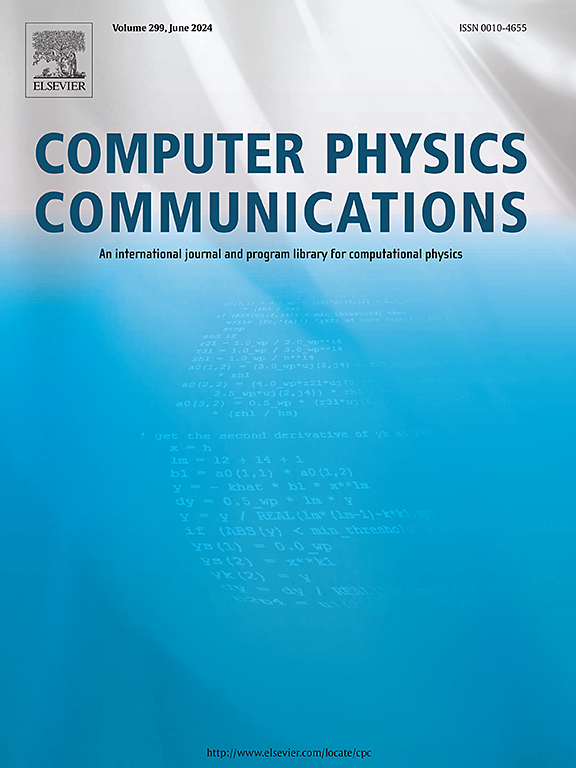ExaGRyPE: Numerical general relativity solvers based upon the hyperbolic PDEs solver engine ExaHyPE
IF 7.2
2区 物理与天体物理
Q1 COMPUTER SCIENCE, INTERDISCIPLINARY APPLICATIONS
引用次数: 0
Abstract
ExaGRyPE describes a suite of solvers and solver ingredients for numerical relativity that are based upon ExaHyPE 2, the second generation of our Exascale Hyperbolic PDE Engine. Numerical relativity simulations are crucial in resolving astrophysical phenomena in strong gravitational fields and are fundamental in analyzing and understanding gravitational wave emissions. The presented generation of ExaGRyPE solves the Einstein field equations in the standard CCZ4 formulation under a 3+1 foliation and focuses on black hole space-times. It employs a block-structured Cartesian grid carrying a higher-order Finite Difference scheme with full support of adaptive mesh refinement (AMR), it facilitates massive parallelism combining message passing, domain decomposition and task parallelism, and it supports the injection of particles into the grid as static data probes or as moving tracers. We introduce the ExaGRyPE-specific building blocks within ExaHyPE 2, and discuss its software architecture and compute-n-feel.
For this, we formalize the creation of any specific astrophysical simulation with ExaGRyPE as a sequence of lowering operations, where a few abstract logical tasks are successively broken down into finer and finer tasks until we obtain an abstraction level which can directly be mapped onto a C++ executable. The overall program logic is fully specified via a domain-specific Python interface, we automatically map this logic onto a more detailed set of numerical tasks, subsequently lower this representation onto technical tasks that the underlying ExaHyPE engine uses to parallelize the application, before eventually the technical tasks in turn are mapped onto small task graphs including the actual astrophysical PDE term evaluations, initial conditions, boundary conditions, and so forth. These can be injected manually by the user, or users might instruct the solver on the most abstract user interface level to use out-of-the-box ExaGRyPE implementations. We end up with a rigorous separation of concerns which shields ExaGRyPE users from technical details and hence simplifies the development of novel physical models. We present the simulations and data for the gauge wave, static single black holes and rotating binary black hole systems, demonstrating that the code base is mature and usable. However, we also uncover domain-specific numerical challenges that need further study by the community in future work.
ExaGRyPE:基于双曲 PDEs 求解引擎 ExaHyPE 的广义相对论数值求解器
ExaGRyPE 描述了一套基于 ExaHyPE 2 的数值相对论求解器和求解器成分,ExaHyPE 2 是我们的第二代 Exascale 双曲 PDE 引擎。数值相对论模拟对于解决强引力场中的天体物理现象至关重要,也是分析和理解引力波发射的基础。新一代 ExaGRyPE 在 3+1 对折下以标准 CCZ4 公式求解爱因斯坦场方程,重点关注黑洞时空。它采用块状结构的笛卡尔网格,搭载高阶有限差分方案,完全支持自适应网格细化(AMR),促进了大规模并行性,将消息传递、域分解和任务并行性结合在一起,并支持将粒子作为静态数据探针或移动追踪器注入网格。为此,我们将使用 ExaGRyPE 创建任何特定天体物理模拟的过程形式化为一连串降低操作,其中一些抽象逻辑任务被连续分解为越来越细的任务,直到我们获得可直接映射到 C++ 可执行文件的抽象级别。整体程序逻辑通过特定领域的 Python 界面进行完全指定,我们自动将这一逻辑映射到更详细的数值任务集上,然后将这一表示降低到底层 ExaHyPE 引擎用于并行化应用程序的技术任务上,最后再将技术任务反过来映射到小型任务图上,包括实际的天体物理 PDE 项评估、初始条件、边界条件等。这些可以由用户手动注入,或者用户可以在最抽象的用户界面上指示求解器使用开箱即用的 ExaGRyPE 实现。我们最终实现了严格的关注点分离,使 ExaGRyPE 用户免受技术细节的影响,从而简化了新型物理模型的开发。我们介绍了规波、静态单黑洞和旋转双黑洞系统的模拟和数据,证明了代码库的成熟和可用性。不过,我们也发现了一些特定领域的数值挑战,需要社区在今后的工作中进一步研究。
本文章由计算机程序翻译,如有差异,请以英文原文为准。
求助全文
约1分钟内获得全文
求助全文
来源期刊

Computer Physics Communications
物理-计算机:跨学科应用
CiteScore
12.10
自引率
3.20%
发文量
287
审稿时长
5.3 months
期刊介绍:
The focus of CPC is on contemporary computational methods and techniques and their implementation, the effectiveness of which will normally be evidenced by the author(s) within the context of a substantive problem in physics. Within this setting CPC publishes two types of paper.
Computer Programs in Physics (CPiP)
These papers describe significant computer programs to be archived in the CPC Program Library which is held in the Mendeley Data repository. The submitted software must be covered by an approved open source licence. Papers and associated computer programs that address a problem of contemporary interest in physics that cannot be solved by current software are particularly encouraged.
Computational Physics Papers (CP)
These are research papers in, but are not limited to, the following themes across computational physics and related disciplines.
mathematical and numerical methods and algorithms;
computational models including those associated with the design, control and analysis of experiments; and
algebraic computation.
Each will normally include software implementation and performance details. The software implementation should, ideally, be available via GitHub, Zenodo or an institutional repository.In addition, research papers on the impact of advanced computer architecture and special purpose computers on computing in the physical sciences and software topics related to, and of importance in, the physical sciences may be considered.
 求助内容:
求助内容: 应助结果提醒方式:
应助结果提醒方式:


